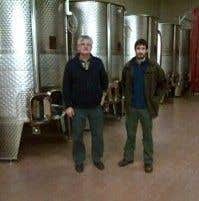See also our Guide to 2011 burgundy coverage, Vignettes from London and Vignettes from the Côte de Beaune.
As well as the Burgundy producers new to me that I visited in November 2011 (François Buffet in Volnay, François Carillon in Puligny, Jean Chauvenet of Nuits, Olivier Jouan in the Hautes-Côtes but with some Côte d'Or sites, Boisson-Vadot – who wouldn't show their 2011s – in Meursault, and the Livera family's Dom des Tilleuls in Gevrey-Chambertin), I visited three old favourites in new premises.
Olivier Bernstein, whom I first visited in a rather untidy garage in a Gevrey backstreet, now operates in a 15th-century palatial vaulted-stone former Hospices storehouse in northern Beaune. He's come up with a smart new label too 'By' Olivier Bernstein – a bit like By Farr in Geelong. I was also able to visit Cécile Tremblay in her equally capacious new premises just opposite the Hotel Très Girard in Morey-St-Denis – although in her case they have been custom built with many a modern convenience. Her 2011s were vinified in her old cellars in Gevrey; 2012 is the vintage that christened the new premises. She told me how she and a winemaker friend – Philippe Charlopin perhaps? – had vinified two halves of the same lot of grapes separately and how very different the results were.
Thanks to the hotel, there is a large car park just outside Tremblay's particularly tall new winery. I drew up there one day, only to find myself just next to Robert Parker's man in Burgundy Antonio Galloni pausing to take stock in his hire car; apt since it had been a bottle of Cécile's wine we had shared over dinner at the Très Girard almost exactly a year before.
I also visited Dutch-Australian mini-négociant Mark Haisma at his third (or is it fourth?) address, in a large, unglamorous but efficacious modern warehouse in the industrial estate in the far eastern suburbs of Gevrey, past the tennis club Le Complexe that seems to have supplanted Chez Guy as the village restaurant where all the vignerons hang out at lunchtime.
It was Haisma who, with some chutzpah, highlighted the effect of all these foreigners moving in to the Côte d'Or. 'The fight that's out there for grand cru fruit is just insane, especially with all these new négociants that are American or Asian owned'. He lost his Morey-St-Denis source in 2011 but has a replacement for 2012.
Speaking of incomers, it was interesting to follow up on the long-term effects of the sale of the Château de Gevrey to a businessman from Macau. Eric Rousseau, who is to make the wine for him, was unstinting in his praise for his connoisseurship. If I understood him correctly, the small amounts of Ch de Gevrey fruit from the Lavaut-St-Jacques and Charmes-Chambertin vines will go into the Armand Rousseau bottlings. At Dom des Tilleuls just up the road by the Château, Damien Lavera told me that they had managed to acquire a bit of AC Bourgogne vineyard from the Ch de Gevrey.
You may remember from a year ago that Fourrier's new négociant business Jean-Marie Fourrier was inspired by the rising prices of vineyard land in Burgundy and his realisation that the only way he would ever get to vinify grand cru fruit was by doing so as a négociant. Land prices continue to spiral. There were rumours that the Canadian backer of Pascal Marchand, French-Canadian small négociant, had recently took over fermage of 1.7 ouvrées, a tiny area, of Le Musigny in time for the 2012 harvest. Rumours (which Marchand describes as 'eccentric') put the price paid at several million euros. Fourrier is concerned that, with two small harvests in the cellar – 2011 and especially 2012 – family businesses with many shareholders wanting to see regular financial returns will be particularly vulnerable to offers from well-heeled outsiders. Over the last three years, many domaines have effectively lost a whole year's worth of volume of wine.
When I visited Denis Bachelet I could hear his 24-year-old son washing and clinking bottles next door. Like so many of those in charge of family-owned domaines, he is particularly worried about the punitive effect of inheritance taxes in France.
Sylvain Cathiard, now in his early sixties, has meanwhile managed to hand over vinification to his quiet, bearded son Sebastien (they are pictured above) – with no obvious ill effects, though it must be a wrench, particularly when the newly refurbished winemaking premises are so much better equipped than during his own era. Sylvain's farewell vintage was 2010, the first in the new winery. Sebastien has worked at Fromm in Marlborough and at Ch Smith Haut Lafitte in Bordeaux. I asked him what he learned in Bordeaux. 'Making wine in big quantities', he said with a smile.
At Domaine de la Romanée-Conti, as elsewhere, the narrow streets throbbed with the sound of trucks picking up wine. I watched as a whole pallet-load of DRC made its shrinkwrapped way across Vosne's Place de l'Église on its way to Ficofi's clients in Asia. Aubert de Villaine gave the following telling figures for the average DRC yields over recent vintages:
2009: 30 hl/ha
2010: 25 hl/ha
2011: 25 hl/ha
2012: 18-20 hl/ha
He also recounted how a recent issue of France's wine magazine La Revue du Vin de France had a picture of a bottle of 2012 Romanée-Conti on the front cover, with its price inside – even though the label, with its new four levels of verification, is two years from existence, and the price certainly has not yet been decided.
I will continue with these sort of observations from the Côte d'Or if there is sufficient demand. Meanwhile, back to the tasting table....

